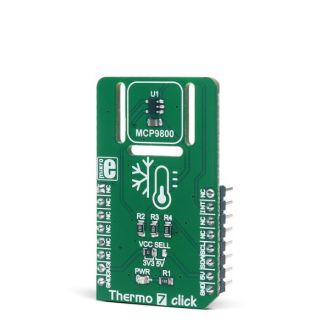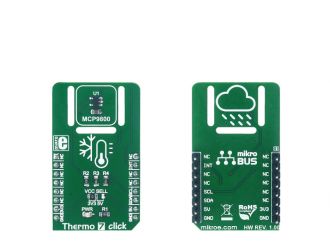
We strongly encourage users to use Package manager for sharing their code on Libstock website, because it boosts your efficiency and leaves the end user with no room for error. [more info]

Rating:
Author: MIKROE
Last Updated: 2018-04-05
Package Version: 1.0.0.0
mikroSDK Library: 1.0.0.0
Category: Temperature & humidity
Downloaded: 6274 times
Not followed.
License: MIT license
Thermo 7 click is a Click board equipped with the sensor IC, which can digitize temperature measurements between -55°C and +125°C so that the temperature measurement data can be processed by the host MCU.
Do you want to subscribe in order to receive notifications regarding "Thermo 7 click" changes.
Do you want to unsubscribe in order to stop receiving notifications regarding "Thermo 7 click" changes.
Do you want to report abuse regarding "Thermo 7 click".


Library Description
The library initializes and defines I2C bus drivers and driver functions that offer a choice for writing data in registers and reading data from registers. The library offers the possibility of setting the upper and lower temperature limits, and the main thing is reading the ambient temperature.ADC resolution can be set to 9bit, 10bit, 11bit or 12bit, with an accuracy of 0.5 C, 0.25 C, 0.125 C or 0.0625 C. The user can adjust the state and behavior of interrupt pins in the set modes. Modes that can be set are Interrupt mode and Comparator mode..
Key functions:
float thermo7_readAmbientTemperature() - Function reads ambient temperature
void thermo7_setConfiguration(uint8_t configuration) - Function for configuration chip and measurement
void thermo7_setResolution(uint8_t resolution) - Function sets ADC resolution measurement
Examples Description
The application is composed of three sections:
void applicationTask()
{
AmbientTemperature = thermo7_readAmbientTemperature();
FloatToStr( AmbientTemperature, tempText );
mikrobus_logWrite( " Ambient temperature : ", _LOG_TEXT );
mikrobus_logWrite( tempText, _LOG_TEXT );
mikrobus_logWrite( " °C", _LOG_LINE );
Delay_ms( 1000 );
}
Other mikroE Libraries used in the example:
Additional notes and information
Depending on the development board you are using, you may need USB UART click, USB UART 2 click or RS232 click to connect to your PC, for development systems with no UART to USB interface available on the board. The terminal available in all MikroElektronika compilers, or any other terminal application of your choice, can be used to read the message.